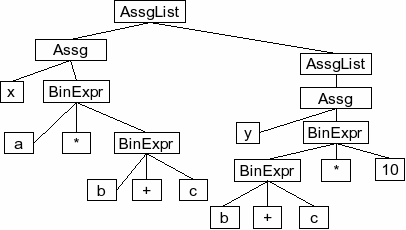Compilation Methods SS 2013 - Assignment 1
Kastens, Pfahler, 17.04.2013Exercise 1 (Different forms of intermediate code)
The following intermediate code fragments are given in 2-address-form (Team 1), 0-address-form/stack-form (Team 2), and tree representation (Team 3).
Note: Both instruction sequences initialize the variables a, b, and c. Those assignments are omitted in the tree representation.
mov local-4, 10 # a mov local-8, 20 # b, mov local-12, -30 # c, mov %eax, local-12 # c, c add %eax, local-8 # tmp59, b imul %eax, local-4 # tmp61, a mov local-16, %eax # x, tmp61 mov %eax, local-12 # c, c mov %edx, local-8 # tmp62, b add %edx, %eax # tmp62, c mov %eax, %edx # tmp64, tmp62 sal %eax, 2 # tmp64, add %eax, %edx # tmp64, tmp62 sal %eax # tmp65 mov local-20, %eax # y, tmp65 |
0: bipush 10 2: istore_0 3: bipush 20 5: istore_1 6: bipush -30 8: istore_2 9: iload_0 10: iload_1 11: iload_2 12: iadd 13: imul 14: istore_3 15: iload_1 16: iload_2 17: iadd 18: bipush 10 20: imul 21: istore_4 |
||

|
Reconstruct a sequence of Java (or C) assignments that could be compiled to this intermediate code and prepare to explain the relationship to the other teams. Do you find optimization opportunities (Slide 202) in your intermediate code representation?
Exercise 2 (Translating statements to intermediate code)
Convert the following assignment statement to intermediate code in 0-address-form, 2-address-form, and an abstract syntax tree-representation. Assume that all variables are declared with type int.
c = (a + b) * (a + b) - 1;
The subexpression a+b appears twice. How could you avoid duplicate computation of the sum in each of the three forms of intermediate code?
Exercise 3 (Optimizations of Java Bytecode)
Which optimizations of Slide 202 are applied by the Java compiler? Which optimizations could have been applied additionally?
public class Optimization {
public static int deadVariables() { public static int deadVariables();
int a = 50; 0: bipush 50
int b = 60; 2: istore_0
3: bipush 60
int x = a + b; 5: istore_1
x = 5; 6: iload_0
7: iload_1
return x; 8: iadd
} 9: istore_2
10: iconst_5
11: istore_2
12: iload_2
13: ireturn
public static int algebraicSimplification() { public static int algebraicSimplification();
int p = 50; 0: bipush 50
double i = 2 * 3.14; 2: istore_0
int j = p + 0; 3: ldc2_w #2; //double 6.28d
int k = p * 2; 6: dstore_1
return j + k; 7: iload_0
} 8: iconst_0
9: iadd
10: istore_3
11: iload_0
12: iconst_2
13: imul
14: istore 4
16: iload_3
17: iload 4
19: iadd
20: ireturn
public static boolean bool;
public static int constantPropagation() { public static int constantPropagation();
int x = 2; 0: iconst_2
if (bool) { 1: istore_0
int z = 42; 2: getstatic #4; //bool
} 5: ifeq 11
int y = x * 5; 8: bipush 42
10: istore_1
return y; 11: iload_0
} 12: iconst_5
13: imul
14: istore_1
15: iload_1
16: ireturn
public static int copyPropagation() { public static int copyPropagation();
int p = 40; 0: bipush 40
2: istore_0
int x = p; 3: iload_0
int z = x; 4: istore_1
5: iload_1
return z; 6: istore_2
} 7: iload_2
} 8: ireturn
Exercise 4 (HOMEWORK: Manually modifying Java bytecode)
The Java classfile CountDown.class
contains an important Java program that has been developed for
upcoming NASA Mars missions. Unfortunately the source code has been lost.
All that is left is a bytecode listing of class CountDown in
file CountDown.j. This file has been generated
from the the classfile.
Use the Java interpreter to execute the supplied classfile. What is wrong with the program (from the NASA's point of view)?
Modify the assembler source code in file
CountDown.jso that the countdown works as expected.Use the command ~compiler/bin/Jasmin CountDown.j to assemble a new classfile, when you have fixed the assembler source code. Invoke the resulting classfile with the bytecode verifier enabled:
java -verify CountDown
Hints:
You can find an overview on Java Bytecode instructions at
http://en.wikipedia.org/wiki/Java_bytecode_instruction_listings.
Generiert mit Camelot | Probleme mit Camelot? | Geändert am: 13.06.2017


